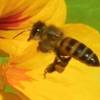Abstract
Cape honey bees can produce both male and female offspring parthenogenetically. Unlike other African bee races, they are docile, but unlike all other races of honey bees, they are social parasites. Find out why South African beekeepers consider Cape bees a more serious threat than the varroa mite in this 4-page fact sheet. Written by James D. Ellis and published by the UF Department of Entomology and Nematology, December 2011.
EENY-513/IN916: Cape Honey Bee Apis mellifera capensis Escholtz (Hymenoptera: Apidae) (ufl.edu)
References
Hepburn HR. 2001. The enigmatic Cape honey bee, Apis mellifera capensis. Bee World 82:181-191. https://doi.org/10.1080/0005772X.2001.11099525
Hepburn HR, Radloff SE. 1998. Honeybees of Africa. Springer-Verlag, Berlin, Germany. 370 pp. https://doi.org/10.1007/978-3-662-03604-4
Johannsmeier MF. 2001. Beekeeping in South Africa. Plant Protection Handbook No. 14, Agricultural Research Council, Pretoria, South Africa. 288 pp.

